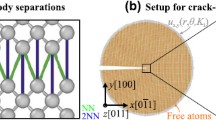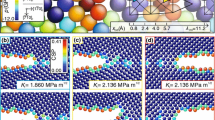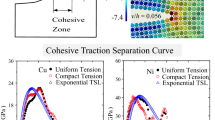Abstract
The atomistic relaxation method developed by the author to study the core structures of edge and screw dislocations in crystalline solids was used to investigate the configurations of atoms and crack-tip atom cohesion and stress fields in BCC (body-centered cubic) and FCC (face-centered cubic) iron. Single crystallites containing initially an atomically sharp and through crack (a vacancy sheet) of various orientations were subjected to tensile strain applied normal to the crack. It is shown that the crack tip stress fields depend importantly on the orientation of the crack with respect to the parent lattice, a result unexpected of existing linear elasticity and continuum theories.
Zusammenfassung
Die vom Verfasser entwickelte atomistische Relaxationsmethode zur Untersuchung von Stufen- und Schraubenversetzungskernen in kristallinen Festkörpern wurde zur Ermittlung sowohl der Atomlagen als auch von Kohäsions-kräften und Spannungsfeldern auf Grund der Atomlagen in der Nähe von Bruchspitzen in kubisch raum- und flächen-zentriertem Eisen verwendet. Einkristalle mit atomistisch scharfen, durchgehenden Rissen (einer Leerstellenebene) verschiedener Orientierung wurden senkrecht zum Riß gedehnt. Es konnte gezeigt werden, daß das Spannungsfeld an der Spitze des Risses im hohen Masse von der Orienticrung des Risses bezüglich des Grundgitters abhängt; dieses Ergebnis ist nicht aus derzeitig bekannten linearen Elastizitäts- oder Kontinuumstheorien ableitbar.
Résumé
Le but de la methode de relaxation atomistique développée par l'auteur était d'étudier les structures intimes des dislocations-coin et des dislocations-vis dans les solides cristallins. Cette methode fut employée afin d'examiner les configurations d'atomes, la cohesion d'atomes aux extremites de fissures des cristaux ainsi que leurs champs de contraintes dans le fer cubique centré et cubique à faces centrées. Des monocristallites contenant à l'origine une fissure atomiquement aigue et profonde (un plan de lacunes) à diverses orientations furent soumises à une traction où la force était appliquée perpendiculairement à la fissure. Il y a lieu de souligner ici que les champs de tension sur les extrémités de la fissure dépendent d'une manière importante de l'orientation de la fissure elle-même par rapport au réseau de base, ce qui révèle un résultat inattendu des théories de l'élasticité linéaree et du Continu, théories jusqu'ici en vigueur.
Similar content being viewed by others
References
A. Kelly, Strong Solids, Clarendon Press, Oxford (1966).
E. Orowan, Rep. Prog. Phys., 12 (1949) 185.
F. Zwicky, Phys. Z., 24 (1923) 131.
J. H.DeBoer, Trans. Faraday Soc., 32 (1936) 10.
J. K. Mackenzie, Ph.D. Thesis, Bristol (1949).
M. Born and R. Furth, Proc. Camb. Phil. Soc., 36 (1940) 454.
J. J. Gilman, Mechanical Behavior of Crystalline Solids, NBS Monograph 59, (1963) p. 79.
A. Kelly, W. R. Tyson and A. H. Cottrell, Phil Mag., 15 (1967) 567.
W. R. Tyson, Phil. Mag., 14 (1966) 925.
C. E. Inglis, Trans. Inst. Naval Arch., 55 (1913) 219.
V. Schmidt, Conf Proc. on Yield and Fracture, Inst. of Phys. Soc., Conf. Series, 1 (1966) 24.
H. A. Elliot, Proc. Phys. Soc., 59 (1947) 208.
J. L. Cribb and B. Tomkins, J. Mech. Phys. Solids, 15 (1967) 135.
J. R. Rice and G. F. Rosengren, J. Mech. Phys. Solids, 16 (1968) 1–12.
J. W. Hutchinson, J. Mech. Phys. Solids, 16 (1968) 13–32.
See, e.g., R. A. Johnson, J. Phys. Chem. Solids, 26 (1965) 75.
M. Doyama and R. M. J. Cotterill, Phys. Rev., 137 (1965) A994.
H. B. Huntington and J. E. Dickley, Phys. Rev., 100 (1955) 1117.
R. M. J. Cotterill and M. Doyama, Phys. Letters, 14 (1965) 79.
Roger Chang and L. J. Graham, Phys. Star. Solidi, 18 (1966) 99.
Roger Chang, Phil. Mag., 16 (1967) 1021.
W. A. Harrison, Pseudo-Potentials in the Theory of Metals, W. A. Benjamin Press (1966).
R. A. Coldwell-Horsfall, Phys. Rev., 129 (1963) 22
Roger Chang and L. J. Graham, Proceedings International Conf. on Point Defects Calculations, National Bureau of Standards, Misc. Publication 287 (1967) 53.
R. A. Johnson, same as reference [42], p. 39.
R. Chang, Second International Conference on Fracture, Brighton, England (1969), Chapman & Hall, p. 306.
Taken from Selected Values of Chemical Thermodynamic Properties, National Bureau of Standards, U.S. Government Printing Office, Washington, D.C., (1952).
A. A. Abrahamson, Phys. Rev., 178 (1969) 76.
Author information
Authors and Affiliations
Rights and permissions
About this article
Cite this article
Chang, R. An atomistic study of fracture. Int J Fract 6, 111–125 (1970). https://doi.org/10.1007/BF00189819
Received:
Issue Date:
DOI: https://doi.org/10.1007/BF00189819




